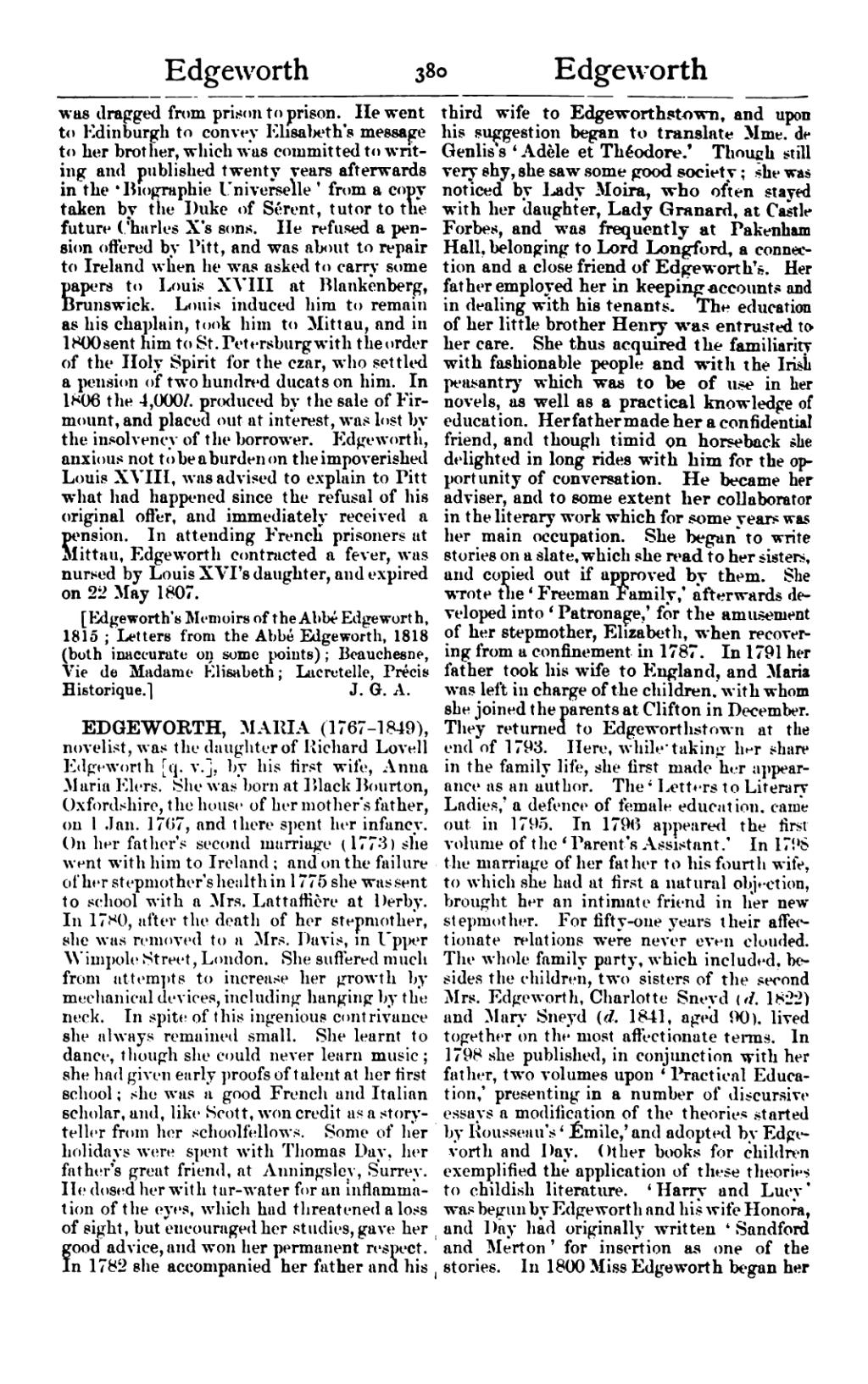was dragged from prison to prison. He went to Edinburgh to convey Elisabeth's message to her brother, which was committed to writing and published twenty years afterwards in the ‘Biographie Universelle’ from a copy taken by the Duke of Sérent, tutor to the future Charles X's sons. He refused a pension offered by Pitt, and was about to repair to Ireland when he was asked to carry some papers to Louis XVIII at Blankenberg, Brunswick. Louis induced him to remain as his chaplain, took him to Mittau, and in 1800 sent him to St. Petersburg with the order of the Holy Spirit for the czar, who settled a pension of two hundred ducats on him. In 1806 the 4,000l. produced by the sale of Firmount, and placed out at interest, was lost by the insolvency of the borrower. Edgeworth, anxious not to be a burden on the impoverished Louis XVIII, was advised to explain to Pitt what had happened since the refusal of his original offer, and immediately received a pension. In attending French prisoners at Mittau, Edgeworth contracted a fever, was nursed by Louis XVI's daughter, and expired on 22 May 1807.
[Edgeworth's Memoirs of the Abbé Edgeworth, 1815; Letters from the Abbé Edgeworth, 1818 (both inaccurate on some points); Beauchesne, Vie de Madame Elisabeth; Lacretelle, Précis Historique.]
EDGEWORTH, MARIA (1767–1849), novelist, was the daughter of Richard Lovell Edgeworth [q. v.], by his first wife, Anna Maria Elers. She was born at Black Bourton, Oxfordshire, the house of her mother's father, on 1 Jan. 1767, and there spent her infancy. On her father's second marriage (1773) she went with him to Ireland; and on the failure of her stepmother's health in 1775 she was sent to school with a Mrs. Lattaffière at Derby. In 1780, after the death of her stepmother, she was removed to a Mrs. Davis, in Upper Wimpole Street, London. She suffered much from attempts to increase her growth by mechanical devices, including hanging by the neck. In spite of this ingenious contrivance she always remained small. She learnt to dance, though she could never learn music; she had given early proofs of talent at her first school; she was a good French and Italian scholar, and, like Scott, won credit as a story-teller from her schoolfellows. Some of her holidays were spent with Thomas Day, her father's great friend, at Anningsley, Surrey. He dosed her with tar-water for an inflammation of the eyes, which had threatened a loss of sight, but encouraged her studies, gave her good advice, and won her permanent respect. In 1782 she accompanied her father and his third wife to Edgeworthstown, and upon his suggestion began to translate Mme. de Genlis's ‘Adèle et Théodore.’ Though still very shy, she saw some good society; she was noticed by Lady Moira, who often stayed with her daughter, Lady Granard, at Castle Forbes, and was frequently at Pakenham Hall, belonging to Lord Longford, a connection and a close friend of Edgeworth's. Her father employed her in keeping accounts and in dealing with his tenants. The education of her little brother Henry was entrusted to her care. She thus acquired the familiarity with fashionable people and with the Irish peasantry which was to be of use in her novels, as well as a practical knowledge of education. Her father made her a confidential friend, and though timid on horseback she delighted in long rides with him for the opportunity of conversation. He became her adviser, and to some extent her collaborator in the literary work which for some years was her main occupation. She began to write stories on a slate, which she read to her sisters, and copied out if approved by them. She wrote the ‘Freeman Family,’ afterwards developed into ‘Patronage,’ for the amusement of her stepmother, Elizabeth, when recovering from a confinement in 1787. In 1791 her father took his wife to England, and Maria was left in charge of the children, with whom she joined the parents at Clifton in December. They returned to Edgeworthstown at the end of 1793. Here, while taking her share in the family life, she first made her appearance as an author. The ‘Letters to Literary Ladies,’ a defence of female education, came out in 1795. In 1796 appeared the first volume of the ‘Parent's Assistant.’ In 1798 the marriage of her father to his fourth wife, to which she had at first a natural objection, brought her an intimate friend in her new stepmother. For fifty-one years their affectionate relations were never even clouded. The whole family party, which included, besides the children, two sisters of the second Mrs. Edgeworth, Charlotte Sneyd (d. 1822) and Mary Sneyd (d. 1841, aged 90), lived together on the most affectionate terms. In 1798 she published, in conjunction with her father, two volumes upon ‘Practical Education,’ presenting in a number of discursive essays a modification of the theories started by Rousseau's ‘Émile,’ and adopted by Edgeworth and Day. Other books for children exemplified the application of these theories to childish literature. ‘Harry and Lucy’ was begun by Edgeworth and his wife Honora, and Day had originally written ‘Sandford and Merton’ for insertion as one of the stories. In 1800 Miss Edgeworth began her
